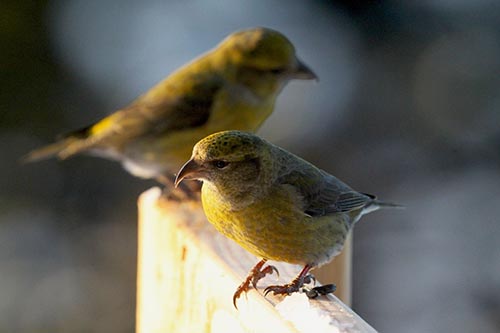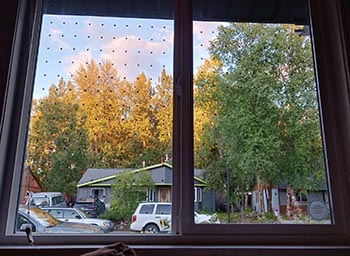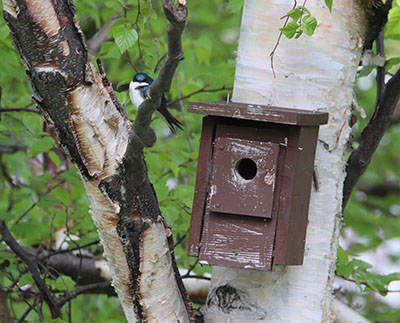Alaska Fish & Wildlife News
September 2024
How to keep birds from hitting your window

The sound of a bird hitting your window is unmistakable and distressing. When my sister and I were startled by the hollow sound this July we went to investigate and found a White-winged Crossbill lying on the ground, stunned but alive. It was raining, so we carefully put the bird in a small box with a towel in the bottom and put it under the eaves so it would not get wet and cold but was away from potential predators. The bird needed some time to recover its bearings and we left it alone for nearly an hour. When I returned to check on it the bird flew away into the trees. While this is comforting to witness, new research suggests that of those birds that sustain injuries from collision, only 40% actually survive. Even though the Crossbill flew away, it still had a 60% chance of succumbing to unseen injuries. Taking into account these numbers as well as birds that die on impact, over 1 billion birds are estimated to die every year from window strike in the United States.
Birds rely heavily on their vision for survival and zip between tree branches and other obstructions flying at 10 or 20 miles an hour, depending on the type of bird. To a bird, window reflections of forest and sky look like safe pathways, causing many birds to be stunned, injured, or killed by flying into them. This worsens considerably during migration season in spring and fall when incredible numbers of birds (many of them inexperienced juveniles) move across the continent. North American bird populations have been in decline since 1970, losing some 3 billion birds collectively from the adult population, with window strike featuring heavily as a cause.
So, what can we do to help prevent bird strikes? Especially as we approach the busy migration season in September when these incidents become more common. Luckily, techniques to reduce bird strikes are fairly accessible.
How to Reduce Window Strikes

When birds fly past buildings, they can hit windows, mistaking the reflections in the glass as gaps in the trees and safe passageways. This is particularly true for buildings adjacent to trees and shrubs. Breaking up these reflections can help birds avoid windows.
There are several options for window treatments to help birds. You can hang cords or medium-weight strings in front of the window. Window screens that keep bugs out prevent reflections, as does painting your own designs on windows.
You can apply tape, decals, adhesives and window films (sometimes called window clings) to break up the window reflections and make the glass apparent to birds. These are most effective when applied to the outside of the window. While there are some recommendations on putting up raptor silhouettes or decoys to deter birds, research does not support that this has a strong effect on bird behavior and is not a sufficient deterrent beyond its function in breaking up window reflection.
Fish and Game has a limited supply of window decals that can deter bird strikes, available at the Anchorage Information Center on Raspberry Road. Stop in during business hours a pick some up if you'd like to address a problem window in your home.
There are new products – adhesives, tapes, window clings and liquid “markers” that can be applied to the glass – that are visible to animals that see ultra-violet (UV) light. The UV spectrum is visible to many birds (and insects, especially bees and butterflies) but it is outside the visible spectrum of light for people. So, the adhesives or marks on the window are relatively transparent to people (at least less conspicuous than traditional decals) but disrupt the reflections and make the glass barrier more apparent to birds.

Spacing is important and adhesives should be spaced no more than 2-4 inches apart and be at least ¼ inch in diameter to give birds the best chance of avoiding it. If there is too much space between decals, then birds may try to dart around them like leaves in a forest. Mimicking dense trees by closely spacing barriers will work far better to deter birds.
You can even avoid washing windows until after migration season so birds can more easily see them. Even temporary measures during migration or fledging season can make a difference.
Bird feeders outside windows can contribute to bird strikes by attracting birds to the proximity of the house and windows, but proper placement can help reduce accidents. Bird feeders should only be up in the winter to avoid attracting bears. A feeder should be either closer than three feet from the window or more than 30 feet away. The close placement is counter-intuitive, but it means the bird will not likely attain enough speed taking off from the feeder to injure itself should it hit the window. These distances apply to birdbaths and birdhouses as well.
Finally, try to turn off your lights at night. Lights pointing into the air can confuse birds during migration season and light from windows can contribute to bird strikes. Lights can be covered by curtains, blinds, or shutters, and keeping lights on timers or on motion detection can also save birds as well as energy and money.
What to do if a bird hits your window

If a bird hits your window, you can inspect it for visible injuries. If the bird seems okay and is just sitting still, try to place it out of bad weather or the reach of predators and leave it be, checking after an hour or so. If the outdoors is not safe, small birds can be placed inside a dry shoebox and taken to a quiet place to recover.
If you see any blood, swelling around the eyes, or labored open-mouth breathing you may be able to take it to a wildlife rehabilitation center. There are two in Alaska that focus on birds: the Bird Treatment and Learning Center (Bird TLC) in Anchorage and the Alaska Raptor Center in Sitka. Both facilities can provide advice, and both take injured birds.
Bird TLC can provide instructions for overnight care, or arrange for a drop-off at the clinic. Their website offers good information and advice for care.
The Alaska Raptor Center (907-747-8662) provides advice regarding an injured bird. Based in Sitka, they have volunteers in Haines, Juneau, Wrangell and Petersburg and may be able to pick up and transport an injured raptor – or advise you how to do it.
Jennifer Cedarleaf is the avian director at the facility, and she is happy to help people who call about an injured bird, including how to pick up and safely handle an injured eagle. They primarily work with raptors at the facility, but she said they will take other birds as long as they can be flown to Sitka.
This advice applies to a bird hitting the window, as opposed to something you find on a beach or a field. If you have found a bird that appears to be sick or is dead and the cause is not apparent, do not handle the bird as it may have Avian Influenza. Report the bird’s location to the Alaska Sick or Dead Bird Hotline at 1-866-527-3358.
Conserving Birds

Encouraging birds to come into your yard with bird feeders and baths is a wonderful occupation that can contribute to happiness, appreciation of nature, and citizen science. But drawing birds towards houses without a few safety measures in place will lead to bird strikes that can add up to hundreds of birds killed over time in one place. With just a few thoughtfully placed decals on your window and some intentional darkness during migration season, bird mortality can be significantly reduced.
Small actions like these paired with keeping house cats indoors (window strike is second only to cats in causes of bird mortality) as well as supporting bird friendly coffee, planting native plants, and contributing to citizen science can have long reaching impacts on the many wonderful bird species found in Alaska.
Arin Underwood is a wildlife biologist with ADF&G’s Threatened, Endangered, and Diversity Program. She works with citizen science projects and supports research on birds and small mammals in Southcentral Alaska.
Subscribe to be notified about new issues
Receive a monthly notice about new issues and articles.
